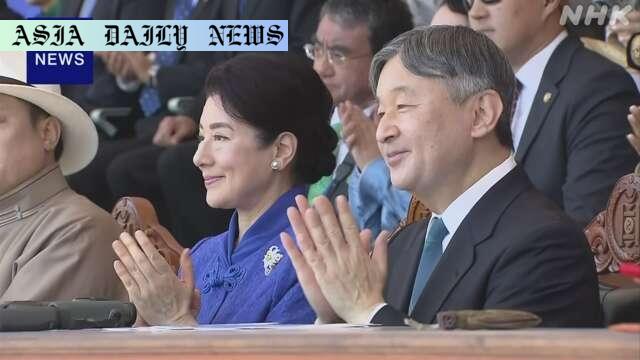Naadam: Japan’s Emperor and Empress honor Mongolia’s UNESCO cultural festival.
Naadam Festival combines history, sports, and culture.
Japan’s Emperor and Empress attend Mongolia’s grand festival.
The festival includes horse racing, archery, and wrestling exhibitions.
Traditions such as the flag of Genghis Khan honor Mongolia’s heritage.

Understanding the Significance of Naadam Festival
The Naadam Festival is one of Mongolia’s most cherished celebrations, encapsulating the nation’s cultural richness and historical legacy. Held annually between July 11 and 13, Naadam is a commemoration of Mongolia’s revolution day and an opportunity to honor its ancient traditions. Recognized as a UNESCO Intangible Cultural Heritage, this event highlights three traditional sports — horse racing, wrestling, and archery — which have been passed down through generations. For the Mongolian people, Naadam is much more than an athletic competition; it symbolizes their identity, resilience, and unity as a nation.
Japan’s Imperial Visit: A Celebration of Friendship
This year, Japan’s Emperor Naruhito and Empress Masako graced the Naadam Festival’s opening ceremony in Ulaanbaatar, fostering cultural and diplomatic ties between Japan and Mongolia. Their presence added a significant sense of occasion to the event, as the couple watched the colorful festivities alongside Mongolian President Ukhnaa Khurelsukh. The audience was further honored by the attendance of Hakuho, the famous former sumo wrestler and Yokozuna Grand Champion hailing from Mongolia.
Cultural Displays and Sporting Excellence
The Naadam festivities began with a parade featuring a mounted troop carrying a flag of Genghis Khan, symbolizing Mongolia’s proud history as the heartland of the ancient Mongol Empire. The Emperor and Empress also witnessed a mesmerizing dance performance that welcomed the state guests and showcased Mongolia’s artistic heritage. They later attended a live archery demonstration, where traditional archers skillfully hit targets placed 100 meters away, drawing cheers and applause from the Imperial couple. The event underscored the skill and discipline required in these traditional games.
The Anticipation of Horse Racing
The Imperial couple is set to observe the horse racing events on the Mongolian grasslands, a highlight of the festival and a cherished tradition. Horse racing stands as a unique representation of Mongolia’s nomadic heritage, where children as young as five compete as jockeys, demonstrating incredible skill and bravery. This segment of the festival is often considered emblematic of the profound bond between Mongolians and their horses, which remain central to their way of life.
Concluding Thoughts: Bridging Cultures Through Heritage
The Naadam Festival serves as a powerful platform to celebrate and preserve Mongolia’s cultural artistry and physical prowess. The attendance of Japan’s Emperor and Empress reflects the enduring diplomatic friendship between the two nations while underscoring the importance of cultural exchange in today’s world. The Imperial couple’s appreciation of the traditions, coupled with their active involvement in cheering the participants, adds a deeper layer of significance to their visit. Festivals such as Naadam aren’t just spectacles; they are living testaments to a community’s legacy that continues to inspire and unite people across borders.



Commentary
Reflecting on Naadam: Celebrating Mongolia’s Legacy
The Naadam Festival is an exemplary celebration of a nation’s cultural identity, blending history, art, and athleticism. From the thrilling horse races to the precise archery contests, each element of Naadam reflects Mongolia’s centuries-old traditions and its people’s unwavering pride in their heritage. Observing this beautiful amalgamation of sports, history, and culture offers not only entertainment but also a glimpse into the soul of Mongolia, making it an event of global significance.
Imperial Presence and Diplomatic Significance
The attendance of Japan’s Emperor Naruhito and Empress Masako adds a poignant narrative to this year’s Naadam Festival. Their participation celebrates not just Mongolia’s rich cultural heritage but also emphasizes the strong bilateral ties between Mongolia and Japan. It was particularly heartwarming to see the Emperor and Empress engaging in the festivities, smiling, clapping, and applauding the participants. Their presence conveys a powerful message: the shared human appreciation for preserving and celebrating traditions, regardless of geography.
The Role of Traditions in Bridging Cultures
In an era where globalization often clouds individual cultural identities, festivals like Naadam play a crucial role in reminding us of the value of heritage. Observing international dignitaries like Emperor Naruhito and Empress Masako honoring Mongolian traditions is a testament to the way culture can bridge nations. Events like Naadam transcend their immediate geographical contexts to become global celebrations of humanity’s shared values of perseverance, skill, and unity.
A Celebration of Universal Values
Ultimately, Naadam exemplifies the universal love for sportsmanship, history, and art. Whether through the breathtaking spectacle of horse races or the precision of archery, the festival demonstrates the timeless appeal of cultural expression. Experiencing Naadam is not just an opportunity to witness Mongolia’s heritage but an invitation to celebrate the shared human spirit that connects us all. Japan’s Emperor and Empress, along with the festival participants, have beautifully reminded us of this enduring truth.